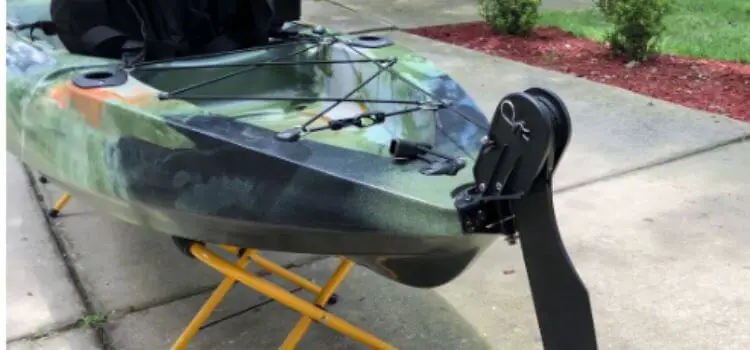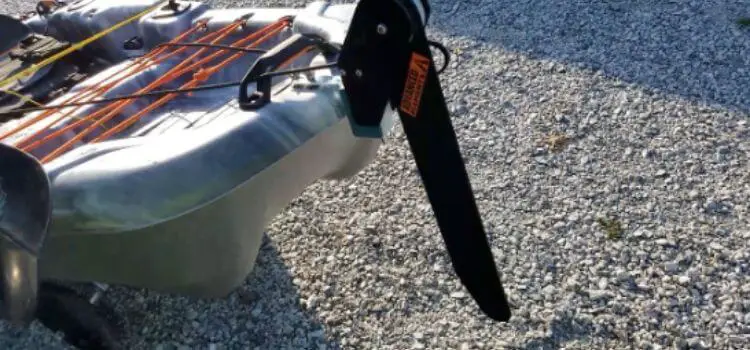As an Amazon Associates, I earn from quality purchases.
Are you ready to enhance your kayaking experience and master the art of maneuverability on the water? If so, learning how to use a kayak skeg can make a significant difference in your kayaking experience.
A kayak skeg serves as a valuable tool for improving tracking and maneuverability. It ensures you stay on course even in challenging conditions. In this article, we will explore the ins and outs of using a kayak skeg effectively. We will provide you with the knowledge and techniques to maximize your kayaking performance.
So, let’s dive in and discover the key steps to mastering the art of utilizing a kayak skeg for a smoother and more enjoyable paddling experience.
What is a Kayak Skeg?

A kayak skeg is a vertical fin-like appendage located on the bottom of a kayak near the stern. It serves as a stabilization device. It assists in maintaining the kayak’s straight tracking while paddling through various water conditions.
There are different types of kayak skegs available. The two main types are fixed skegs and retractable skegs.
1. Fixed Skegs:
These are permanently attached to the kayak’s hull and cannot be retracted. They provide a constant and reliable stabilization effect. They are suitable for kayakers who frequently paddle in conditions that require enhanced tracking.
2. Retractable Skegs:
These skegs can be raised or lowered as needed. They are controlled by a mechanism located within the kayak’s cockpit. They allow the paddler to adjust the skeg’s position based on the current conditions. Retractable skegs offer versatility. They can be used in both calm and rough waters, providing the paddler with more control over their kayak’s performance.
Is a skeg good for a kayak?
Using a kayak skeg can significantly enhance the performance and stability of your kayak. Let’s explore the benefits of using a kayak skeg and compare it to other kayak stability systems such as rudders and fins.
Benefits of using a kayak skeg:
Improved Tracking:
One of the key advantages of a kayak skeg is its ability to improve tracking. It creates additional resistance against the sideways forces caused by wind or currents. They help the kayak maintain a straighter course. This allows you to paddle more efficiently and reduces the need for constant course corrections.
Increased Stability:
A kayak skeg adds stability to your kayak by minimizing the tendency to wobble or rock side-to-side. This stability is especially beneficial when paddling in challenging conditions, such as rough waters or strong crosswinds.
Versatility:
Kayak skegs offer versatility as they can be used in a wide range of water conditions. Whether you’re paddling on calm lakes, open oceans, or winding rivers, a skeg can assist in maintaining control and stability. It is a valuable tool for various kayaking adventures.
What Is the Difference Between a Skeg, a Rudder, and a Fin?
When it comes to kayak stability systems, there are different options available, each serving a distinct purpose. Here’s a breakdown of the differences between a skeg, a rudder, and a fin:
Features | Skeg | Rudder | Fin |
Function | Improves tracking and stability | Provides steering capabilities | Enhances stability |
Control | Fixed or retractable, not steerable | Controlled by foot pedals | Fixed or detachable |
Adjustibility | Limited adjustment or fixed position | Adjustable angle for steering control | Adjustable or removable |
Steering Ability | No steering capabilities | Enables precise steering | No steering capabilities |
Primary Use | Enhancing straight-line paddling | Maneuvering and turning | Stability in dynamic conditions |
Complexibility | Simple setup and operation | Adds complexity to the kayak | May add complexity depending on design |
Suitable for | Open water, windy conditions | Various water conditions | Whitewater or surfing |
Installing a Kayak Skeg

Installing a kayak skeg is a relatively straightforward process that can be done with a few basic tools. Here’s a step-by-step guide on how to install a skeg on your kayak:
Tools Required for Installation:
Before you begin, gather the following tools:
- Screwdriver
- Adjustable wrench
- Drill
- Measuring tape or ruler
Step-by-Step Guide:
Choose the Skeg and Placement:
Select the skeg suitable for your kayak model and the type of paddling you will be doing. Refer to the manufacturer’s instructions for the specific skeg you have. Determine the ideal placement of the skeg on the bottom of your kayak. Generally, it should be positioned near the stern, underneath the kayak.
Prepare the Kayak:
Ensure that the surface of the kayak where the skeg will be installed is clean and dry. Remove any dirt, debris, or old adhesive if necessary. This will help in securing the skeg properly.
Mark the Mounting Holes:
Place the skeg in the desired position on the kayak’s bottom. Use a pencil or marker to mark the mounting hole locations on the kayak’s surface. Double-check the alignment and make sure the skeg is parallel to the centerline of the kayak.
Drill Holes (if required):
If the skeg requires holes for mounting, use a drill with the appropriate size bit to create the holes at the marked locations. Ensure the holes are deep enough to accommodate the mounting hardware.
Attach the Skeg:
Place the skeg back in the marked position, aligning the mounting holes. Insert the screws or bolts provided with the skeg kit through the holes in the skeg and into the pre-drilled holes on the kayak’s bottom. Use a screwdriver or adjustable wrench to tighten the screws or bolts securely. Check that the skeg is firmly attached and does not wobble.
Test and Adjust:
After installing the skeg, test its movement by deploying and retracting it as per the manufacturer’s instructions. Ensure that it moves smoothly and locks securely in both positions. If any adjustments are necessary, follow the manufacturer’s guidelines to make the required modifications.
Final Check:
Before taking your kayak out on the water, give the installed skeg a final inspection. Confirm that it is securely fastened, aligned properly, and functions correctly.
If you are unsure or uncomfortable with the installation process, it is advisable to seek assistance from a professional or an experienced kayaker.
Where Should a Skeg Be on a Kayak?

The placement of a skeg on a kayak plays a crucial role in its effectiveness and performance. While the exact positioning may vary depending on the kayak model and design, there are general guidelines to consider. Here’s where a skeg should typically be located on a kayak:
1. Near the Stern:
The skeg is usually positioned near the stern (rear) of the kayak. It is typically located in the centerline of the kayak, extending downwards into the water. This placement helps to enhance the kayak’s tracking ability and stability.
2. Clear of Obstructions:
The skeg should be positioned in a way that ensures it remains clear of any obstructions, such as the rudder, foot braces, or other kayak accessories. This allows for unimpeded deployment and retraction of the skeg.
3. Adjustable Positioning:
Some kayaks offer adjustable skegs. They can be moved forward or backward to fine-tune the tracking and performance based on the paddler’s preference or the water conditions. These adjustable skegs provide added versatility and customization options.
4. Secure Attachment:
It’s crucial to ensure that the skeg is securely attached to the kayak. This is typically achieved through mounting brackets or fittings. They are designed to withstand the forces encountered during paddling. A secure attachment ensures that the skeg remains in place and functions properly.
Experimenting with different positions and adjusting as necessary will allow you to find the optimal placement that suits your paddling style and the prevailing water conditions.
How to Use a Kayak Skeg
Using a kayak skeg effectively can enhance your paddling experience, especially in challenging water conditions. Here’s a guide on how to properly deploy and retract the skeg, as well as adjust its angle for desired performance:
A. Deploying and Retracting the Skeg:
1. Before Launching:
Before getting on the water, ensure that the skeg is in the retracted position. This allows for easy maneuvering and launching in shallow or rocky areas.
2. Deploying the Skeg:
Once you’re in deeper water and ready to paddle, deploy the skeg by using the mechanism provided by your kayak’s design. It may be a slider, lever, or pull cord located within reach while seated in the kayak. Gradually extend the skeg downward until it reaches the desired depth, usually fully extended.
3. Paddling with the Skeg Deployed:
With the Skeg deployed, you’ll experience improved tracking and stability. The skeg helps counteract the influence of wind and current, allowing you to maintain a straighter course. It reduces the kayak’s tendency to veer off track. It makes paddling more efficient, especially during longer distances.
4. Retracting the Skeg:
If you need to make tight turns, navigate through shallow areas, or paddle in maneuverable situations, retract the skeg. Simply use the designated mechanism to pull the skeg back into its fully retracted position.
B. Adjusting the Skeg Angle for Desired Performance:
1. Understanding Skeg Angle:
Some kayaks have skegs that allow for adjusting the angle while deployed. This feature enables you to fine-tune the skeg’s performance based on different water conditions and your paddling preferences. Angling the skeg slightly can influence the kayak’s behavior without fully retracting it.
2. Experimentation and Adaptation:
To find the optimal skeg angle, start by deploying the skeg fully. Gradually adjust the angle while paddling and observe how it affects your kayak’s tracking and maneuverability. Experiment with small angle adjustments until you find the balance that suits your needs.
3. Factors to Consider:
The ideal skeg angle depends on various factors, including wind direction, current speed, and the kayak’s responsiveness. If you’re paddling against a strong headwind, angling the skeg slightly into the wind can provide better tracking. Conversely, angling it away from the wind may help during crosswinds or quartering conditions.
4. Practice and Adaptation:
As you gain experience and become familiar with your kayak’s behavior, you’ll develop a sense of when and how much to adjust the skeg angle. Practice in different conditions and adapt your adjustments to optimize your kayak’s performance.
Each kayak may have its own deployment and adjustment mechanisms. So refer to the instruction manual provided with your kayak for accurate information. With practice and experience, you’ll master the proper use of the skeg, enhancing your kayaking adventures.
When to Use a Kayak Skeg
Knowing when to use a kayak skeg can significantly improve your paddling experience, particularly in certain water conditions. Here are some factors to consider and situations where a skeg is most effective:
Factors to Consider for Skeg Usage:
1. Wind Conditions:
The wind is a crucial factor when deciding whether to use a kayak skeg. If you’re paddling against a headwind or experiencing strong crosswinds, deploying the skeg can greatly enhance your tracking and stability. The skeg helps counteract the lateral forces caused by wind, reducing the kayak’s tendency to veer off course.
2. Currents and Tides:
In situations where you’re paddling against or across currents, deploying the skeg can assist in maintaining a straight course and minimizing the effects of the current on your kayak’s tracking.
3. Long-Distance Paddling:
During extended paddling trips where maintaining a straight line is important, a skeg can be highly beneficial. It helps prevent the kayak from continuously drifting off course. It reduces the need for constant correction strokes and conserves your energy over long distances.
4. Open Water Conditions:
When kayaking in open waters such as lakes, large rivers, or coastal areas, where the wind and currents have more room to influence your kayak’s path, using a skeg is advantageous. It provides improved tracking and stability. It allows you to focus more on your paddling technique and less on constantly adjusting your course.
Tips for Using a Kayak Skeg
Using a kayak skeg effectively involves proper deployment and adjustment. It also requires maintenance and specific techniques to maximize its benefits. Here are some tips to help you make the most of your kayak skeg:
Maintenance and Care Tips for the Skeg:
1. Regular Inspection:
Periodically inspect your skeg for any signs of damage, such as cracks, loose screws, or excessive wear. Address any issues promptly to prevent further damage and ensure the skeg functions properly.
2. Clean and Lubricate:
Keep the skeg mechanism clean and free from dirt, sand, or debris. Regularly rinse the skeg with fresh water after each use, especially if you’ve been paddling in saltwater. Lubricate the moving parts according to the manufacturer’s recommendations to maintain smooth operation.
3. Protective Storage:
When not in use, store your kayak in a safe and dry location to prevent unnecessary exposure to the elements. If possible, keep the skeg in the retracted position to minimize the risk of accidental damage.
Techniques for Maximizing the Benefits of a Skeg:
1. Gradual Adjustments:
When deploying or retracting the skeg, make adjustments gradually to observe the impact on your kayak’s tracking and maneuverability. Small, incremental changes allow for better fine-tuning. This helps you find the optimal setting for different conditions.
2. Balance with Paddling Technique:
While a skeg can greatly improve tracking, it’s essential to maintain proper paddling technique. Focus on using efficient and consistent paddle strokes, engaging your core muscles, and maintaining good posture. A combination of effective paddling and the skeg’s assistance will optimize your kayak’s performance.
3. Be Mindful of Water Depth:
When paddling in shallow water, be cautious about deploying the skeg fully. The skeg may extend beyond the kayak’s keel and risk hitting rocks or other obstacles. Retracting the skeg or adjusting its depth to a shallower position is advisable in such situations.
4. Experiment in Different Conditions:
Take the opportunity to paddle in various water conditions to familiarize yourself with the effects of the skeg. Practice in calm waters, windy conditions, and areas with different current speeds. By experimenting and observing how the skeg affects your kayak’s performance, you’ll gain valuable experience and learn to adapt to different scenarios.
5. Paddle Responsibly:
A skeg enhances stability and tracking. But it’s important to remember that it doesn’t replace sound judgment and paddling skills. Always consider safety guidelines, weather conditions, and your abilities when planning your kayaking adventures.
By following these tips, you can ensure the longevity and optimal performance of your kayak skeg. Regular maintenance, combined with proper techniques and experimentation, will enable you to make the most of this valuable tool and enhance your overall kayaking experience.
Common Mistakes to Avoid

Using a kayak skeg can greatly improve your paddling experience. But it’s important to be aware of common mistakes that can affect the skeg’s performance. Here are some mistakes to avoid and tips to prevent common errors:
Mistakes That Can Affect Skeg Performance:
1. Forgetting to Retract the Skeg:
One common mistake is leaving the Skeg deployed when it’s not needed. This can hinder maneuverability in shallow or rocky areas and increase the risk of damage to the skeg. Always remember to retract the skeg when navigating through such conditions.
2. Overextending or Underextending the Skeg:
Deploying the skeg too far or not enough can impact its effectiveness. Overextending the skeg may cause it to catch on objects or increase drag.
Underextending it may not provide the desired tracking benefits. Find the optimal depth for your skeg based on the water conditions and your kayak’s behavior.
3. Neglecting Maintenance:
Failing to perform regular maintenance can lead to issues with the Skeg’s operation. Neglecting to clean and lubricate the mechanism can result in stiffness, difficulty in deployment or retraction, or even corrosion. Keep the skeg well-maintained to ensure its smooth functioning.
Tips to Prevent Common Errors:
1. Double-Check Skeg Position:
Before launching your kayak, always double-check the position of the skeg. Ensure it is fully retracted if you’re in shallow water or an area with potential obstacles. Confirm that it’s fully deployed when you need the added stability and tracking benefits.
2. Gradual Adjustments:
When making adjustments to the skeg position, do so gradually. Make small changes and observe their effects on your kayak’s performance. This allows you to find the optimal setting without making drastic adjustments that could negatively impact your paddling experience.
3. Follow the Manufacturer’s Guidelines:
Each kayak and skeg model may have specific instructions and recommendations from the manufacturer. Familiarize yourself with these guidelines. Adhere to them for proper use, maintenance, and any specific considerations related to your particular kayak and skeg.
4. Practice in Different Conditions:
To become familiar with the skeg’s behavior and optimize its use, practice paddling in various water conditions. This includes calm waters, windy conditions, and areas with different currents. By gaining experience in different scenarios, you’ll better understand the skeg’s effects and be able to adapt accordingly.
5. Regular Maintenance Routine:
Establish a regular maintenance routine for your kayak and skeg. This includes rinsing the skeg with fresh water after each use, checking for any signs of damage or wear, and lubricating the mechanism as recommended by the manufacturer. By taking care of your equipment, you can prevent issues that may affect the skeg’s performance.
By avoiding these common mistakes and following the provided tips, you can ensure optimal performance and longevity of your kayak skeg.
Disadvantages of a kayak skeg.
While a kayak skeg offers several benefits in terms of tracking and stability, it’s important to consider the potential disadvantages associated with its use. Here are some drawbacks to keep in mind:
1. Limited Maneuverability:
One of the main disadvantages of a kayak skeg is that it can limit the kayak’s maneuverability, especially in tight or narrow waterways. When the skeg is deployed, it reduces the kayak’s ability to make quick turns or navigate through obstacles with ease. This can be a drawback in situations that require agile maneuvering.
2. Dependence on Manual Adjustment:
Unlike other stability systems like rudders, skegs often require manual adjustment. This means you need to reach down and physically deploy or retract the skeg. It can be challenging or inconvenient, particularly in rough or challenging conditions.
3. Limited Effectiveness in Strong Crosswinds:
While a skeg can assist in counteracting wind forces, it may have limitations in strong crosswind situations. In extremely gusty conditions, the skeg’s impact on maintaining a straight course may be diminished.
4. Risk of Damage or Snagging:
The protruding nature of the skeg increases the risk of damage or snagging on underwater objects, especially in shallow or rocky areas. Care must be taken to avoid running aground or colliding with submerged obstacles that could potentially cause harm to the skeg or impede its functionality.
5. Complex Installation Process:
Installing a kayak skeg can be more complex compared to other stability systems. It often requires drilling holes or mounting brackets onto the kayak’s hull, which may be a deterrent for paddlers who prefer a simpler setup or those who frequently switch between different kayaks.
6. Less Effective in Certain Water Conditions:
While a skeg excels in improving tracking in open water or against headwinds, it may not offer the same level of benefit in all water conditions. In calm or sheltered environments, where wind and currents have minimal influence, the skeg’s impact may be less noticeable, making it less advantageous in such situations.
It’s important to assess your specific paddling needs, preferences, and the type of water conditions you’ll encounter before deciding whether a kayak skeg is the right choice for you.
You may also read: How to Use a Kayak Cart?
Conclusion
Understanding how to use a kayak skeg is essential for enhancing your paddling experience. By deploying a skeg correctly, you can improve tracking, stability, and overall control of your kayak.
Whether you’re paddling in windy conditions, dealing with challenging currents, or simply seeking better maneuverability, the proper use of a skeg can make a noticeable difference. Remember to adjust the skeg angle according to the water conditions and your desired performance.
By following the tips and techniques outlined in this article, you’ll be able to harness the full potential of a kayak skeg and navigate with confidence. So, get out on the water, deploy your skeg, and enjoy a smoother, more controlled kayaking adventure!
Frequently Asked Questions (FAQs):
Q: Can I install a retractable skeg on any kayak?
A: Retractable skegs can be installed on most kayaks, but you should check with the manufacturer to ensure compatibility.
Q: Do I always need to use a kayak skeg?
A: No, skegs are typically only necessary in windy or choppy conditions. In calm, flat water conditions, a skeg may not be needed.
Q: How much should I lower my skeg?
A: Start with a small amount of skeg and gradually increase it as needed. Use small, subtle movements to avoid over-correcting.
Q: Can I use a kayak skeg to turn more sharply?
A: No, skegs are designed to improve tracking and stability, not to turn more sharply. To turn more sharply, use your paddle.
Q: How do I know if I need a kayak skeg?
A: If you’re kayaking in windy or choppy conditions and having difficulty maintaining control, a kayak skeg may be necessary. The skeg can help you maintain a straight course and provide additional stability, making it easier to paddle in rough conditions.

Leave a Reply